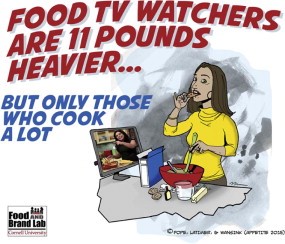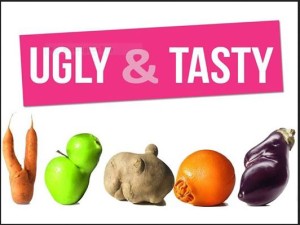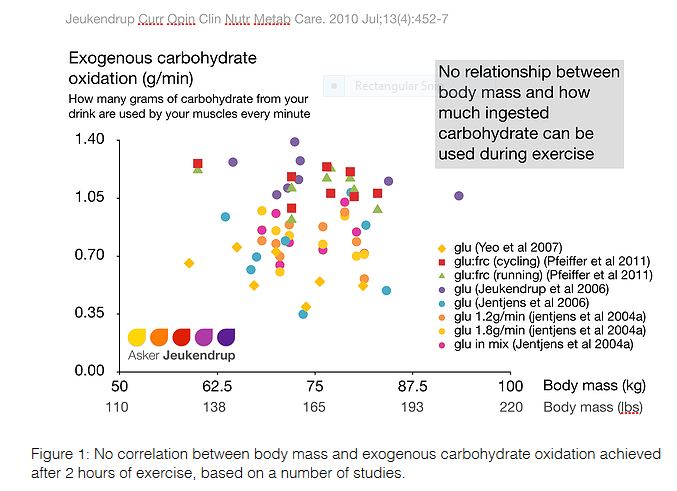This week, read about cooking shows making people fat, why heavier athletes don’t need more carbs during activity, how fonts influence health behavior, a questionable diet soda and weight study, limiting food waste with ugly but tasty produce, and more.
 Do TV Cooking Shows Make Us Fat?
Do TV Cooking Shows Make Us Fat?
Researchers from Cornell’s Food and Brand lab investigated how women obtained information on new recipes, and asked a series of questions about their cooking habits, their weight, and height. Researchers found that women who obtained recipes and food information from TV cooking shows and those viewers who cooked from scratch had a higher BMI [body mass index] that those who didn’t watch Food TV. These findings suggest that it’s a good idea for cooks to look beyond TV for recipes. “Because many cooking shows normalize overconsumption and gratification, it comes as no surprise that viewers’ culinary habits are negatively influenced,” says study author Pope. The authors encourage promoting healthy foods on cooking shows to positively influence the weight status of viewers. (NPR reporting on Appetite, March 2015).
Drinking Diet Soda Linked to a Widening Waistline with Age. A new study published this week showed that older people who drink diet soda daily increased their waist circumference compared to their peers who drank other beverages. The study controlled for factors like physical activity, diabetes and smoking. Authors speculate that people who drink diet soda may be more likely to overeat in other areas. (Scientific American reporting on Journal of the American Geriatrics Society, March 17). The study was criticized by Yoni Freedhoff on his Weighty Matters blog here, because it didn’t control for diet as a whole. The issue might not with the diet soda, but drinking diet beverages might just identify people who eat more caloric foods overall.
A Badly Flawed New York Times Story Trumpets Cell Phone Health Dangers. A story in the New York Times this week on the dangers surrounding cellphones and new wearable gadgets was poor science reporting in many ways. At least editors changed the original headline “Could Wearable Computers Be as Harmful as Cigarettes?” You’ll find another good look at the poor science reporting by Andrew Maynard of the University of Michigan’s Risk Science Center here, and another excellent piece by Nick Stockton of Wired Magazine here. I think Stockton nails the main issue with this:
“This article is about science, and how conspiracy-miners like Bilton misrepresent science to manufacture support for controversial ideas. . . Bilton’s argument follows a familiar formula: Make a provocative claim, back it up by cherry-picking from the scientific literature, throw in commentary from an “expert” or two, and season throughout with attacks on less-than-complete scientific data.”
Food Safety: researchers find towels to be a top source of cross contamination in the kitchen. Kansas University researchers observed areas of weakness when it comes to consumers’ kitchen behavior. It’s a good idea to wash cloth towels frequently! Other tips include good hand washing and not using sponges (see article for a full list). (Medical Health Express, reporting on Food Protection Trends, January 2015).
Study finds being near greened vacant lots lowers heart rates. Researchers from the University of Pennsylvania explored the connection between city environments and stress, using heart rate as a marker of stress. Study participants walked through two randomly selected Philadelphia neighborhoods on a prescribed path. One neightbourhood had vacant lots with a “greening treatment,” while the other neighborhood had neglected vacant lots. The “green” lots elicited lower heart rates, suggesting less stress. (American Journal of Public Health)
Healthy diet based on UK dietary guidelines reduces risk of cardiovascular disease by a third in over-40s. A study published this week in the American Journal of Clinical Nutrition found that following the UK dietary guidelines (compared to the normal British Diet) could significantly reduce heart attack and stroke risk. The UK guidelines diet involved eating more fruits and vegetables, oily fish once/wk, replacing refined grains with whole grains, swapping high-fat dairy products and meats for low-fat alternatives, limiting salt and sugar intake, and replacing cakes and cookies with fruit and nuts. (American Journal of Clinical Nutrition, March 2015).
MIND diet (Mediterranean-DASH) may significantly protect against Alzheimer’s disease. More research showing that what’s good for the heart, is also good for the brain. (Journal of the Alzheimer’s Association, March, 2015). Find out more about the DASH and Mediterranean diets here.
The power for fonts: the right font can help sway health behavior (clear & simple=good; ditch comic sans & complex). (The Atlantic)
Do heavier athletes need more carbs during activity? Although larger athletes need more calories and carbs in general, during activity, weight doesn’t matter: recommendations are the same for a 50 kg (110 pound) female athlete and a 90 kg (198 lbs) athlete. This is because the limiting factor is absorption in the intestine, and you can only use what you are able to absorb. For activity > 2 hours, carb intake of 60-90 grams/hour is often recommended.(Mysportscience.com, reporting on Jeukendrup Curr Opin Clin Nutr Metab Care 2010 Jul; 13(4):452-457)
Coke a healthy snack? How company gets its message out. Company pays dietitians and others to endorse the product. (Medical Express)
Don’t insist on perfect looking produce! We’re throwing away tons of fruits & veggies for not being pretty enough. (Washington Post). In Canada, Loblaws is starting an ugly fruit line called Naturally Imperfect – read more about it here. Second Life (@iMoches) is a campaign started by students in Canada to get “uglies” into retailers (read more about it here). You’ll find more information on ending food waste here.
Why ‘BPA-Free’ May Be Meaningless. Chemicals that replace BPA (often Bisphenol S (BPS) and bisphenol F (BPF)) may have nearly the exact impact on the human body (hormone disruption) as BPA. Using less plastic (BPA free or not) is generally a good idea anyways. To minimize exposure, drink from steel/glass containers, don’t microwave anything in plastic, and be aware that BPA substitutes may still contain unhealthy chemicals (Time, reporting on Environmental Health Perspectives, March 2015).
Share This: